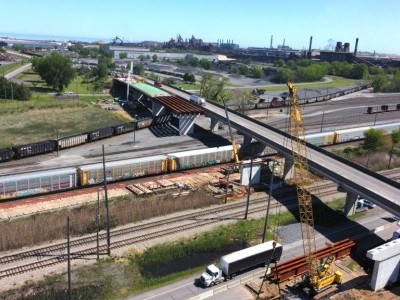U.S. Great Lakes-St. Lawrence Seaway Ports busy in November
Dec 16, 2020American ports in the Great Lakes-St. Lawrence Seaway System report a busy November as businesses stockpile for the end of the year. In November, shipments of U.S. agriculture and wind turbine components remain steady as they have been throughout the 2020 navigation season, while steel movement picks up pace before the year’s end.
Craig H. Middlebrook, Deputy Administrator of the U.S. Saint Lawrence Seaway Development Corporation said, “As the 2020 Seaway navigation season heads into its final few weeks, we are encouraged by the amount of activity at our ports. Even though total tonnage is still not at last year’s levels for this time of year, the number of vessels transiting the Great Lakes Seaway System is significant.”
Amidst a challenging navigation season, overall tonnage across the Great Lakes-St. Lawrence Seaway System is down only 6.6 percent compared to this time last year, narrowing a 10.2 percent deficit reported in May 2020.
From the opening of the St. Lawrence Seaway on April 1, 2020 through November 30, 2020, American and Canadian ports handled a total of 32.3 million metric tons (mt). At this time last year, American and Canadian ports handled a total of 34.5 million metric tons (mt).
Top-performing Great Lakes-St. Lawrence Seaway commodities through October 2020
Commodity |
Metric Tons Handled |
Growth* |
Grain** |
10,945,000 mt |
23.2 percent increase** |
Gypsum |
779,000 mt |
31.1 percent increase* |
Liquid Chemicals |
436,000 mt |
0.7 percent increase* |
Steel Slabs |
365,000 mt |
127.9 percent increase* |
Asphalt |
347,000 mt |
45.7 percent increase* |
*Percentages rounded to nearest tenth (compared year-over-year)
**Combined U.S. and Canadian
American Ports Picking Up Pace, Moving International Cargos
American ports in the Great Lakes-St. Lawrence Seaway System were busy throughout November, trading with an estimated 40 countries across the world. During the month, ports such as Cleveland, Detroit and the Illinois International Port District, benefited from bustling international traffic that delivered critical cargos for global industries, like steel slabs, steel coils, timber and machinery.
“The last quarter of the year has been progressively trending upward. From a tonnage standpoint, our cargo continues to be diversified, which was one of our main goals,” said Dave Gutheil, Chief Commercial Officer, Port of Cleveland. “We have seen some new cargos into Cleveland within the last two months, and we expect that to continue before the end of the season in 2020.”
Similar Stories

Stacking Cranes Market Outlook 2034
View ArticleDunkerque-Port: A Pioneer in port innovation and sustainability
With a 5% growth in maritime traffic in 2024, Dunkerque-Port stands out as a strategic and innovative player in the European port sector. Driven by its commitment to diversification and…
View Article
Port of Prince Rupert moved 23.1M tonnes of cargo in 2024 amid historic expansion phase
View Article
Port of Long Beach’s Cordero hails ‘Green Port’ achievements
View Article
Steering the Ship, Jess Ramirez Sworn In as President of Oxnard Harbor District
View Article
Jeffersonville port delivers record road salt shipments to Greater Louisville area during recent winter storms
View ArticleGet the most up-to-date trending news!
SubscribeIndustry updates and weekly newsletter direct to your inbox!





